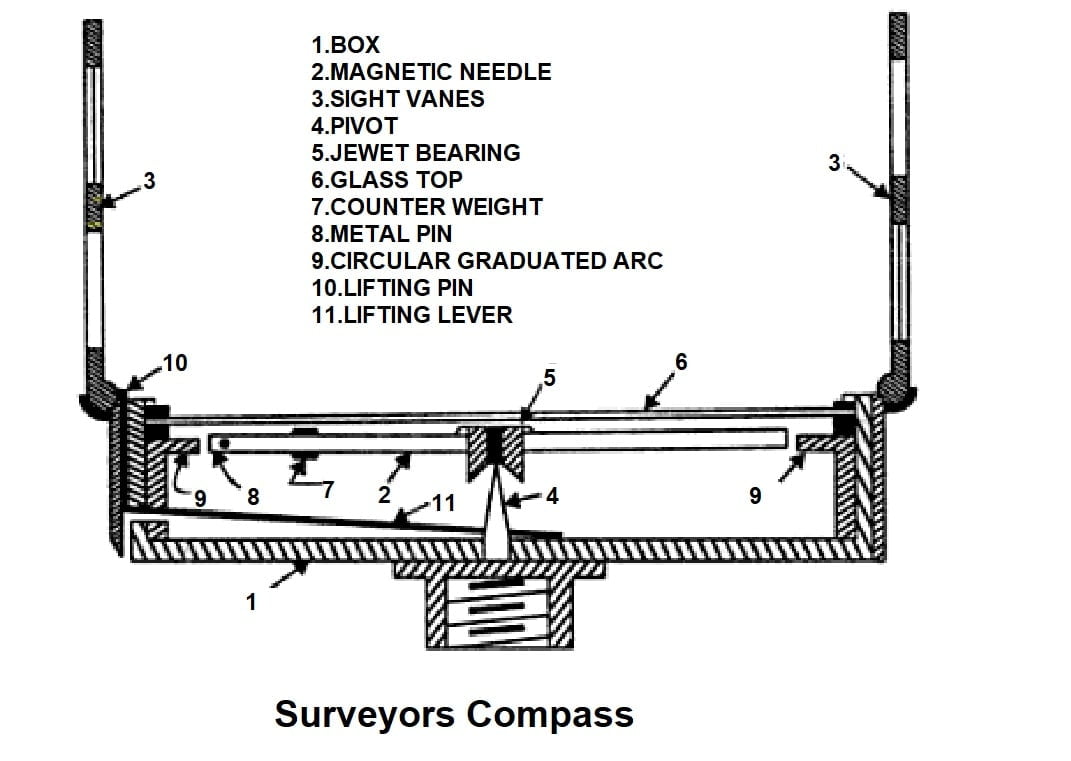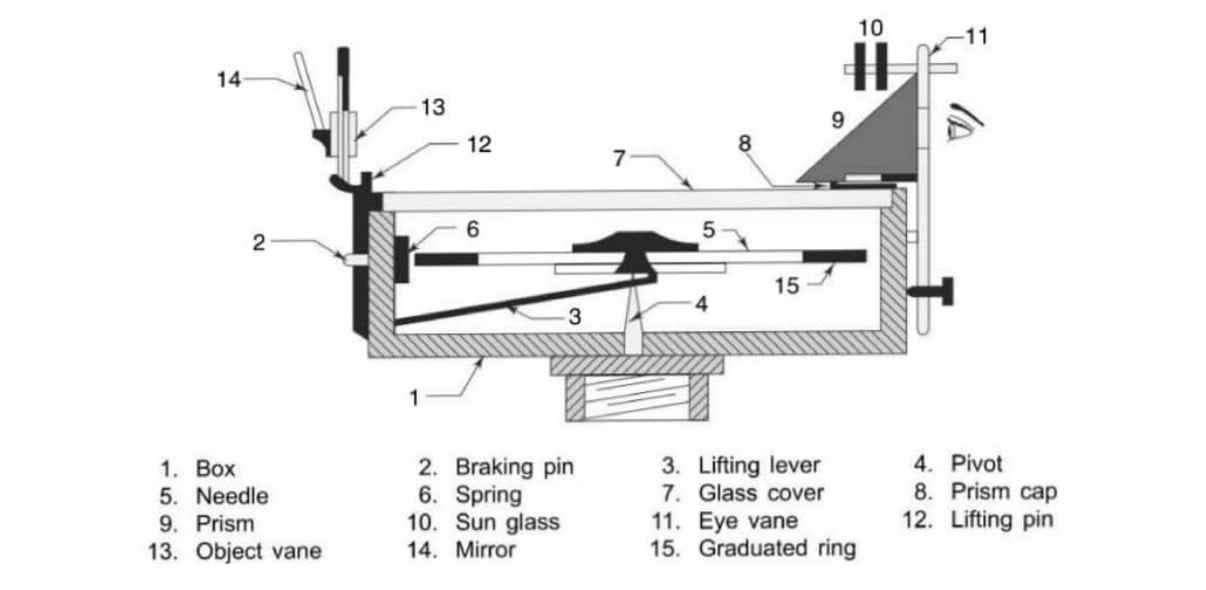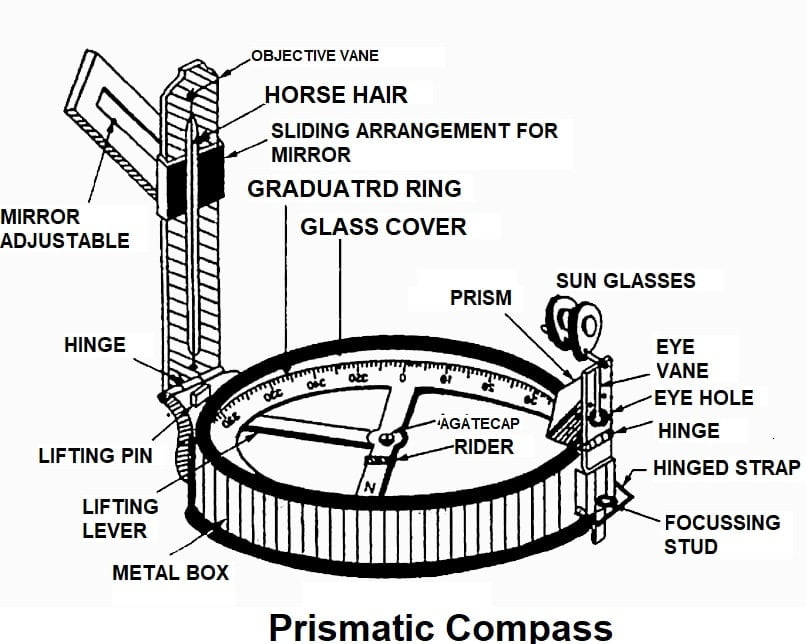Difference Between Surveyor Compass and Prismatic Compass
Compass
Compass is a survey instrument used for the measurement of horizontal angles and the bearing of a line of sight. Magnetic compasses used in compass traversing.
Temporary & Permanent Adjustments Of Compass
Temporary adjustments
- Temporary adjustments are also known station adjustments. These adjustments are made at every set-up of the instrument.
- These adjustments consist of fixing the instrument to the tripod, centering and levelling it. Whenever the instrument is shifted to other stations, the temporary adjustments are changed and they have to be repeated.
Permanent Adjustments
- Permanent adjustments once made generally last for a long time, and these need not be repeated for a considerable period of time. The permanent adjustments of the instrument are generally done in the laboratory or workshop by skilled persons.
- The permanent adjustments are required to ensure that various components of the instrument are in the proper adjustments such that they perform the function properly.
- For example, in a surveyor's compass if the magnetic needle is not straight and sensitive, the permanent adjustment of the needle will be required.
Compass are generally two types
- Surveyor Compass
- Prismatic Compass
Surveyor Compass
- It consists of a brass or aluminium circular box of about 150 mm diameter.
- The graduated ring is directly fixed to the box which governs the size of the compass normally that is in the range of 10-15 cm ( but can extend up to 5cm – 20cm).
- The graduation is marked in degree and haff degree.
- The magnetic needle is made up of magnetic steel that swings freely over a brass circle. A small metal rider or sliding weight is provided on the needle to counteract the effect of dip. The rider can be slid along the needle so that the needle lies in a horizontal plane.
- The surveyors compass is used for measurement of quadrantal bearing. The least count of a surveyors compass is 15 minutes (15ꞌ).
- Graduations in this compass go from 0 to 90 degrees, with 0 representing north or south and 90 degrees representing east and west.An angle of 40 degrees to the north direction to the east is written as N 40 ° E and an angle of 60 degrees to east from the south is written as S 60 ° E. The reading is taken at the tip of the needle.
- It's a tool for calculating horizontal angles. To determine the surveying line of sight's bearing.
- It is simple to use, as well as portable and lightweight.


Temporary adjustments of a Surveyor's Compass
The following temporary adjustments are done after fixing the surveyor's compass on the tripod.
- Centring
- Levelling
Centring
- Centring is the process of setting up the instrument exactly over the station peg. The centering is done by moving the legs of the tripod. If the compass has an arrangement for attaching a plumb bob to its base, the centering is considered when the plumb bob is exactly over the peg fixed on the station.
- A compass does not need very accurate centering, unlike very precise instruments such as a theodolite.
Levelling
- Levelling is required so that the graduated ring is horizontal and it swings freely on the pivot. Both the ends of the needle should be in level with the graduated ring.
- If levelling screws and level tubes are fitted to the compass, the levelling is achieved by manipulating the levelling screws.
- If there are no levelling screws, the levelling is done by the ball-and-socket arrangement.
Permanent Adjustment of Surveyor's compass
- Adjustment of levels
- Adjustment of sight vanes
- Adjustment for sensitivity of the needle
- Adjustment for straightness of the needle.
- Adjustment of pivot.
Prismatic Compass
- The prismatic compass is a magnetic compass in which there is a prism for taking observations, thereby it is termed as Prismatic Compass. A prismatic compass is portable. It can be used as a hand instrument or can be fitted on a tripod.
- The prismatic compass is generally smaller in size than a surveyor's compass.
- The prismatic compass consists of a circular box, about 85 to 100 mm diameter.
- The magnetic needle used in a prismatic compass is broad in shape.
- An aluminum ring graduated in degrees and half degrees is directly attached with the needle.
- The graduations on the aluminium ring increase clockwise from 0 to 360°, with the zero of the graduations coinciding with the south end of the needle, 90° graduation is at the west, 180° graduation at the north and 270° graduation at the east.
- The prismatic compass is used for the determination of the whole circle bearings (W.C.B.) of the lines. The least count of a prismatic compass is 30 minutes (30ꞌ).
- Because of the prism, precise readings can be taken.It may be used as a tripod or in hand because it is lightweight and portable.


Temporary Adjustments of a Prismatic Compass
The following temporary adjustments are done after fixing the prismatic compass on the tripod.
- Centring
- Levelling
- Focussing
Centring
- Centring is the process of setting up the instrument exactly over the station peg. The centering is done by moving the legs of the tripod. If the compass has an arrangement for attaching a plumb bob to its base, the centering is considered when the plumb bob is exactly over the peg fixed on the station.
- A compass does not need very accurate centering, unlike very precise instruments such as a theodolite.
Levelling
- Levelling is required so that the graduated ring is horizontal and it swings freely on the pivot. Both the ends of the needle should be in level with the graduated ring.
- If levelling screws and level tubes are fitted to the compass, the levelling is achieved by manipulating the levelling screws.
- If there are no levelling screws, the levelling is done by the ball-and-socket arrangement.
Focussing
The prism is moved up or down in its slide till the graduations on the aluminium ring are seen to be clear, sharp and in perfect focus.
Permanent adjustment of prismatic compass
The permanent adjustments of a prismatic compass are similar like a surveyor's compass, but they are much simpler. The following differences should be noted.
- Adjustments of levels: In a prismatic compass, there are no level tubes hence, there is no adjustment of levels.
- Adjustments for sight vanes: Sight vanes in a prismatic compass are not adjustable.
- Adjustments of the needle and pivot: Needle in a prismatic compass cannot be straightened.
Difference Between Prismatic Compass and Surveyor Compass
| Prismatic Compass | Surveyor's Compass |
| In the prismatic compass whole circle bearing are calculated. | In the surveyor compass quandrantal bearing are calculated. |
| The graduated ring (scale) is attached with the needle and does not rotate with rotating the box. Graduatrd Ring free to float along with the broad type magnetic needle. | The graduated ring is attached with the box (needle is free to rotate) and graduated ring rotate with rotating the box. |
| The graduations on the aluminium ring increase clockwise from 0 to 360°, with the zero of the graduations coinciding with the south end of the needle, 90° graduation is at the west, 180° graduation at the north and 270° graduation at the east. | Graduations in this compass go from 0 to 90 degrees, with 0 representing north or south and 90 degrees representing east and west.An angle of 40 degrees to the north direction to the east is written as N 40° E and an angle of 60 degrees to east from the south is written as S 60 ° E. The reading is taken at the tip of the needle. |
| Needle are Broad type. (Fitted at the bottom of aluminum ring) | Needle are Edge bar type.-also acts as an index |
| The readings are taken with the help of a prism, provided at the eye vane. Sighting and Reading both can be done simultaneously | The readings are take directly by seeing through top of box glass. First sighting and then Reading. |
| The instrument can be held in hand also while making the observations. | The instrument cannot be used without a tripod. |
FOR MORE INFORMATION ABOUT SURVEYING
Difference Between Surveyor Compass and Prismatic Compass
Source: https://esenotes.com/compass-surveyor-compass-prismatic-compass/